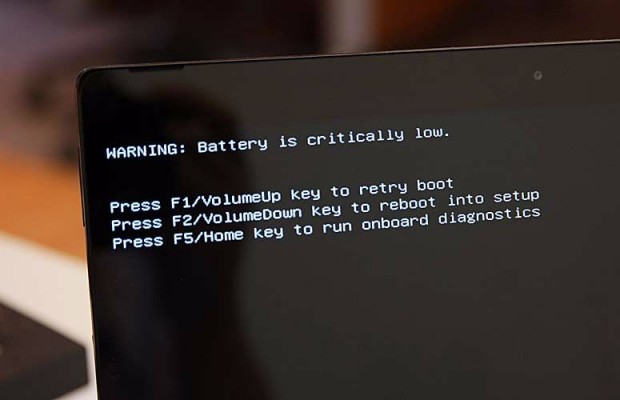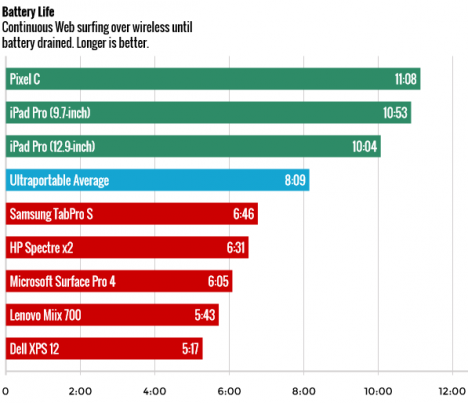Windows Detachables Have Big Battery Life Problem
Detachable 2-in-1s, such as Microsoft's Surface Pro 4 and HP's Spectre x2, make up one of the few bright spots of PC sales, because they offer the versatility of both a tablet and a laptop in one device. In fact, according to analyst firm IDC, shipments of 2-in-1s are expected to quadruple over the next four years. But lurking behind the superthin bodies and sparkling screens of Windows detachables lies a troubling trend we’ve seen on almost every device we’ve tested: weak battery life.
It's gotten so bad that the average battery life of the last six detachable devices we've tested stands at just 5 hours and 57 minutes. Compare that time to our current 8-hour average for ultraportable laptops, and you can see why we're so disappointed. Our battery test isn't the most taxing, either: It involves simple Web surfing over Wi-Fi at 100 nits of screen brightness (often half or even a third of a given 2-in-1's maximum).
The Samsung TabPro S is the best of this underperforming bunch, lasting 6 hours and 46 minutes, while Microsoft's most recent detachable, the Surface Pro 4, lasted a disappointing 6:05. Then we get to even more anemic systems, such as the Lenovo Ideapad Miix 700 and the Dell XPS 12, which conked out after just 5:43 and 5:17, respectively.
Apple's iOS-powered iPad Pro (10:04 for the 12.9-inch model and 10:53 for the 9.7-inch model) and Google's Android-powered Pixel C (11:08) offer at least 4 hours more juice than the average Windows detachable. To be fair, the iPad Pro and the Pixel C feature operating systems designed for phones — and the iPad Pro's keyboard lacks a touchpad — but it's clear that right now, cramming an Intel Core processor and Windows 10 into a slim slate is not a recipe for staying power.
You might ask, "But what about the Surface Book?" Yes, its 12.5 hours of runtime is quite impressive, but it's not really the same type of system as the Surface Pro 4 or the Samsung TabPro S. The Surface Book benefits from having a separate battery in its base. Also, its $1,499 starting price is significantly higher than that of other Windows detachables, which makes it more of a MacBook Pro foe.
MORE: Why Your Next Laptop Should Be a 2-in-1
The root of the detachable battery-life problem seems to be in the devices' superthin designs and higher-resolution screens. We saw a similar endurance regression in the smartphone world when companies chased unnecessarily thin designs and quad-HD displays. It took a while for smartphone and mobile chip makers to realize efficiencies and make their high-res handsets last longer.
Sign up to receive The Snapshot, a free special dispatch from Laptop Mag, in your inbox.
Some buyers gladly would sacrifice long battery life for great display quality and a svelte chassis. The 12-inch, 2736 x 1824 display on the Surface Pro 4 is stunning. And one of the big reasons this category as a whole is growing so quickly is the ease with which these devices can be slipped into a briefcase or backpack. It's just hard to get excited about a machine that bites the dust long before your workday is over.
So what is someone looking for a Windows 2-in-1 with good battery life to do? If you don't have the budget for the Surface Book, you could opt for a discounted Surface Pro 3, which lasted a decent (but still below-average) 7:27 on our battery test. If you can live with a slow Atom processor, the regular Surface 3 (8:01) is a pretty good value.
Or, you might want to just forgo a detachable design altogether and opt for a 2-in-1 with a rotating hinge, such as the Lenovo Yoga 900 or the HP Spectre x360 13t. While these machines aren't quite as portable as their detachable cousins, they lasted a fairly strong 7:57 and 8:26, respectively, on our battery test. The added heft also makes them easier to balance on your lap.
Maybe it's just physics to blame, but for now, Windows detachables aren't a great choice for people who care about battery life. Here's hoping the trend won't continue.
Sam Rutherford is a writer at Laptop Mag, focusing on laptop reviews and all the gadgets that make using a notebook just that much easier (or more fun). Over the years, he reviewed some iconic laptops, including gaming beasts from Alienware, Asus, Acer, Gigabyte, and HP. Outside of gaming laptops, Sam has also reviewed notebooks oriented around productivity, such as the Lenovo IdeaPad or the Dell XPS.



